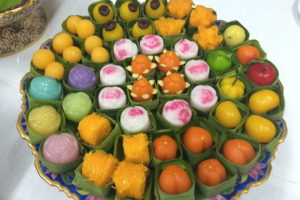Home to one of the world’s most enduring monarchies, this royal kingdom is the only Southeast Asian country never to have been under European rule.

The royal palace
We visit a master confectioner whose hand-crafted regal sweets are fit for a King, explore the forgotten heritage of Bangkok’s Rattanakosin area, and meet the last remaining craftsmen of Baan Batt, the traditional monk’s bowl.
Narrated by Will Yun Lee.
“The Forgotten”
Bangkok.
With each passing day, things look the same. They feel the same. But somehow, it’s all different. You just can’t put your finger on it.

It happens over time… without knowing it. A venerable low-rise building transforms into a gleaming skyscraper. An ages old business morphs into a fast food restaurant. The excitement of the ‘now’ pushes the past to the edges of recognition… shoved to a place where shadows and memory slowly let it slip away.

This is the forgotten heritage of Bangkok.

Join Dr. Piyamas Lernapakun, a scholar at Bangkok’s prestigious Thammasat University, as she embarks on a journey of discovery and loss through the city’s rich, but neglected, legacy.
“Fit for a King”
Thailand is the only Southeast Asian country that has never been under European rule. A constitutional monarchy, the kingdom has had a Thai ruler for more than six hundred years.
But there have been European influences. Bangkok’s railway station is in an Italian Neo-Renaissance-style. Old shophouses have a British colonial flair. The Royal Throne Hall was inspired by King Rama the Fifth’s visit to Europe. The influences are undeniable… albeit with a certain Thai style.
So it’s not surprising that royal sweets within the imperial household originated from Portuguese desserts more than three hundred years ago.

Traditional handmade royal sweets
These days the so-called ‘royal sweets’ available to the public are mass-produced and devoid of taste. But there is one woman who has dedicated herself to maintaining the time-consuming techniques required in handcrafting delectable royal bonbons.
Meet the woman keeping the true royal sweets tradition alive… Master Confectioner Khun Nualchawee.

Master confectioner Khun Nualchawee
Khun Nualchawee focuses on the “Nine Sweets of Prosperity,” a collection of intricate, mouth-watering delights. And her approach is strictly old school.

But if these handmade treats are so good, why are they disappearing?
Join Khun Nualchawee as she demonstrates the labor-intense making of the Ja Mong Kut and the challenges of preserving the Nine Sweets of Prosperity for future generations.
“Food for the Soul”
Bangkok… 5 A.M.

Each morning at dawn, monks from temples across the city head out onto the streets. Winding through the community, they humbly collect alms from neighborhood worshippers.

These offerings are placed into a metal bowl called a ‘Baan Batt.’ Every monk has one. In the Thai Buddhist tradition, a monk can only consume food that has been placed in his bowl.
Ninety-three percent of Thailand’s population follows Buddhism. So there’s a thriving religious supply business to support it. All of the merchandise is mass-produced in factories… including the indispensible monk’s bowl.
But it wasn’t always that way.

Under construction… a new handcrafted monk’s bowl
Once there were three entire villages dedicated to handcrafting these unique bowls.

Hand filing a new baan batt (monk’s bowl)
Now… there are only eight families. And they’ve been doing it for more than three hundred years.
Khun Hiran is a sixth generation baan batt craftsman. He began helping out his parents at age twelve.

Sixth generation craftsman Khun Hiran works on a new monk’s bowl
Join Hiran and the remaining craftsmen as they reveal the unique baan batt-making process, battle against the onslaught of mass-produced bowls, and search for ways to keep this art form alive for generations to come.
It’s all revealed in Episode 3 – Thailand of “Vanishing ASIA.”













